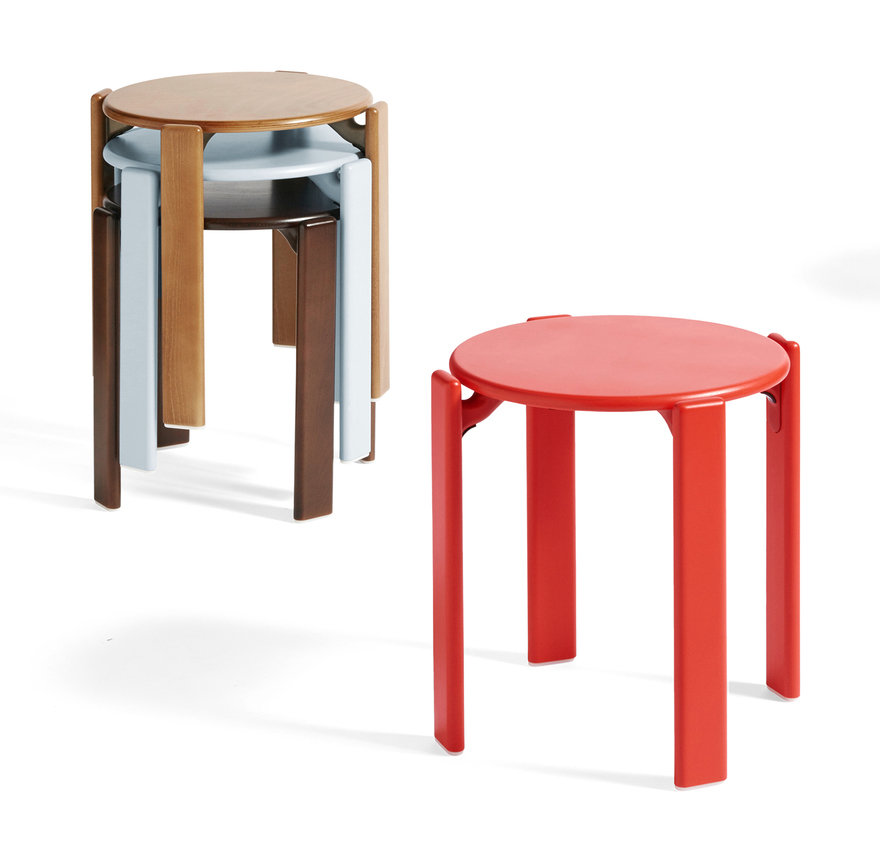Hay Re-releases Iconic Bruno Rey Chair, With Mysterious Joinery Method
An "innovative screwless production process"
Hay is re-releasing Swiss industrial designer Bruno Rey's handsome Rey Chair, which first went into production in 1971. (Originally called the 3300, the chair took on its designer's name as it grew in popularity.)


Stool, barstool and table variants round out the Rey Collection.





The press release, and every design blog parroting it, mentions the chair's "innovative screwless production process," but no explanation of what this entails is mentioned. I poked around a bit and found this description, but no explanatory image, from the Museum für Gestaltung Zürich:
"The most successful piece of Swiss seating furniture of all time is based on an invention patented in 1972. [Bruno Rey] had been working for some time on an alternative to the conventional wooden frame chair. In his design, the chair legs are joined to the self-supporting seat by means of a bonded aluminum console that was handmade using sand casting in 1970/71 and afterward produced using the gravity die casting process."
Here's a shot of an original 3300 for sale on vintage furniture website Design Market, where you can see the "consoles," i.e. connectors, but again no description is given of how they're attached:
 Image: Design Market
Image: Design Market
These fuzzy shots of the child's version of the 3300 from Circa Vintage on Facebook provide a little more visual clarity, but no text description:
 Image: Circa Vintage on Facebook
Image: Circa Vintage on Facebook
 Image: Circa Vintage on Facebook
Image: Circa Vintage on Facebook
 Image: Circa Vintage on Facebook
Image: Circa Vintage on Facebook
We can see that the wood has been routed to accept the connector, but what the heck holds it in place? Finally I found these images on Organ, a Japanese retailer of vintage furniture and objects:
 Image: Organ
Image: Organ
It appears that the connectors are simply glued in place. Puzzlingly, however, I found one shot in Hay's image bank that shows the connector at the bottom, and we see this:

Those look like screw holes, no? I swear I can almost see a glimmer of a screwhead in the top left hole.

In any case, I reached out to a PR rep to see if they have a shot of the chair disassembled, which might provide some clues. Will update this post if I hear back.
-
o1Favorite This
-
Q6Comment
K
{Welcome
Create a Core77 Account
Already have an account? Sign In
By creating a Core77 account you confirm that you accept the Terms of Use
K
Reset Password
Please enter your email and we will send an email to reset your password.



Comments
The Original Ray chair brackets were sand-cast and glued into place with a very strong (and now not legal to produce) glue / resin. It is not possible to find a modern glue with the same mechanical strength that can also meet modern furniture strength tests such as the US BIFMA standards for furniture for public spaces. Therefore I would presume that HAY's development team have had to opt for a screwed connection by modifying the original bracket design. A screwed connection also akes prioduction faster and flat-packing possible. The chemical requirements to glues and paint finishes set by American legislation such as California's Prop 65 which constantly changes has caused a head-ache for any International furniture brand wanting to sell their products on the US market. Core77 ought to look into this and do an article on whether these laws make any real benefits to the market. We Europeans shake our heads at this sort of law, instead of just alligning with international accepted standards for chemical emmissions that have been agreed on between the EU, Asian standards and other countries which previously had their own laws on these matters.
I suspect the black rectangle can be pressed in to release the clips that hold the aluminium connectors to the seat and legs. The glue in the Organ shot looks like it's been (badly) applied later due to probable wear and wobbliness. The screwed version looks like a simplified later style that looks like the original, but has more positive connection. Note it doesn't have the black push button.
A Swiss patent by Bruno Rey from the right time period - might be relevant. Sadly no pictures accompany the text, at least not from the sources I found. https://patents.google.com/patent/CH517469A/de
https://patents.google.com/patent/DE4136611A1/de
Note that the bit you quoted says that Rey started with "sand casting" and then switched to "gravity casting." For those of you who've not worked in a foundry, let me just say that this is some obfuscatory BS. Sand castings are gravity castings since you can't exactly inject molten metal under high pressure into most sand molds. Lost wax castings are also "gravity casting" and unlike sand castings, they can hold a higher level of tolerances with a lower deformation rate. One also doesn't have to do as much clean-up on lost wax casting as you do on sand castings to get the same level of finish.
Yep, that is the noral route of production. Once the sales volume is there, you can invest in a more expensive production method to increase quality and get the unit price down. I have 3 of the original chairs from Kusch, the bracket on these are not sand-cast but die-cast molded.